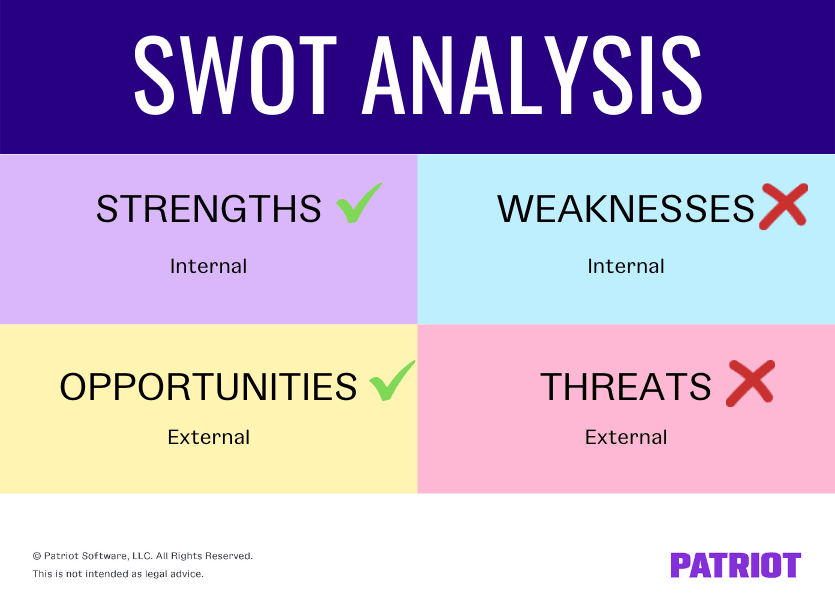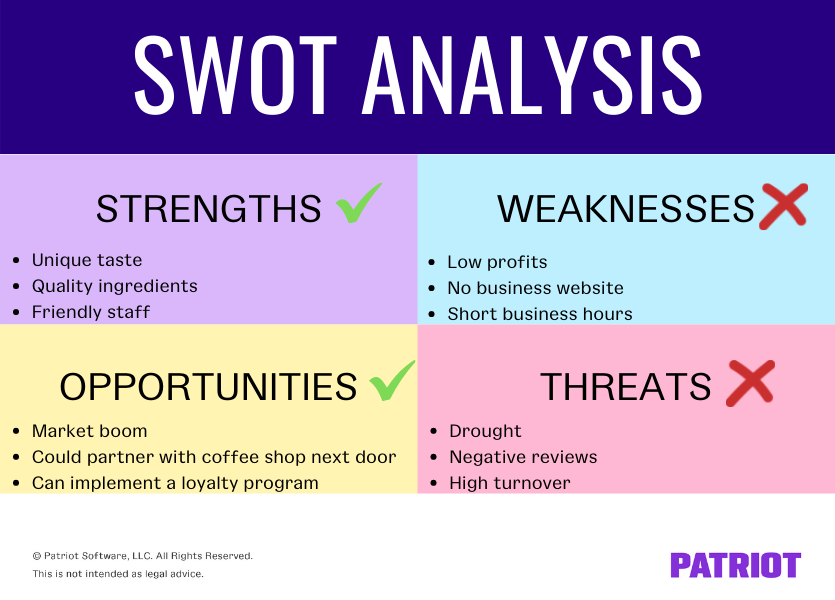How well do you know your business’s strengths and weaknesses? What about your opportunities and threats? If you’re coming up short on answers, you need to conduct a SWOT analysis. So, what is SWOT analysis?
Whether you’re a newbie or veteran entrepreneur, creating a SWOT analysis can help you evaluate your business, implement changes, and improve operations. Read on to get started.
What is SWOT analysis?
A SWOT analysis is a business technique that identifies a business’s strengths, weaknesses, opportunities, and threats. The purpose of SWOT analysis is to look at internal and external factors that influence a business’s successes and shortcomings. Use this tool to establish goals, your competitive position, and a small business growth strategy.
Brad Touesnard, Founder & CEO of SpinupWP, provided insight into the importance of SWOT analysis, saying:
A SWOT analysis allows you to identify the areas you could be focusing on to grow your business. You can use this insight to inform your long-term strategic planning, which will help you to draw up budgetary plans and identify hiring needs.”
You should create a SWOT analysis small business when starting your business. And, you should update your SWOT annually. To conduct a SWOT analysis, you need to do research (e.g., market analysis) and dive into your business’s data (e.g., financial statements). After gathering information, arrange your results using a four-quadrant diagram.
Most of the time, you can use this technique to analyze your business’s overall operations. But, you can also create a focused SWOT that helps you analyze a particular project.
Ready to get into what exactly a SWOT tells you? Here’s a breakdown of SWOT analysis meaning:
- Strengths: What’s your business doing well? (Internal)
- Weaknesses: Where does your business fall short of success? (Internal)
- Opportunities: What can your business be doing to get a boost? (External)
- Threats: What kind of factors can harm your business? (External)
Strengths
Your business’s strengths are the internal aspects of your company that put you ahead of your competition and give you the upper hand when attracting customers.
Strengths also include valuable employees who work for your business. A skillful, kind, and knowledgeable staff sets successful businesses apart from unsuccessful businesses.
Your business’s assets, or property, are also strengths. You have tangible assets, which are physical items, and intangible assets, or non-physical property.
Once you identify your business’s strengths, cater to them. See how you can highlight what your business does best when marketing, cross-selling or upselling, or developing new offerings.
Examples of business strengths:
- Unique value proposition
- Original products or services
- Low prices
- Loyal customers
- Hardworking employees
Weaknesses
In the weakness section of your SWOT analysis, detail things within your business that prevent it from surpassing competitors. To get started, think about your operations. You can also consider what your competitors do better than your business.
So, what does your company lack? What types of limitations do you face when operating? Your business might be weak in some areas by having too broad a vision, mission, or brand. If your business is all over the place, you won’t resonate with your audience.
When you determine your business’s weaknesses, you and your employees should come up with methods to improve them.
Examples of business weaknesses:
- Low profits
- Ineffective systems
- High turnover rates
- Costly processes
- Lack of ingenuity
Opportunities
Your SWOT analysis’s opportunities section looks at external aspects that could give your business a boost. Opportunities are industry- or market-related factors that give your company an advantage over your competition.
Talking about a SWOT analysis’ usefulness in competitive analyses, Malte Scholz, CEO and CPO of Airfocus, says:
SWOT analysis can help you analyze the competition and identify potential gaps in the market. This way, you will be able to position yourself much faster and answer the current needs of your target audience. In order for SWOT analysis to reveal valuable insights, however, it must be executed thoroughly, without rush.”
To determine your opportunities, look at what’s happening outside of your business. Some opportunities are temporary while others are permanent.
Opportunities might make it possible to increase sales or improve your chances of attracting new customers. Regularly determine opportunities and take advantage of them. If opportunities are only temporary, come up with ways to bounce back after the opportunity passes.
Examples of business opportunities:
- Lack of competition
- Demand for your offerings (e.g., face masks during COVID)
- Market growth
- Online presence or coverage
- Sales tax holiday
Threats
Like opportunities, threats are external factors that can harm your business. Although these are often out of your control, identifying threats can help you prepare against them. Like opportunities, threats can be temporary or permanent.
Threats might come from new or improved competitors. Or, they can stem from weaknesses. For example, you might receive negative reviews as a result of a disengaged employee.
You may also see changes in the market that result in a lack of demand. A recession might lead to a lack of consumer spending. Threats might also be due to the environment, like droughts, hurricanes, or severe blizzards.
Although you can’t control threats, you can choose how you react to them. And, you might be able to find opportunities among threats (e.g., federal aid during declared disasters and emergencies). Brainstorm ways to adapt your business when facing threats.
Examples of business threats:
- Drought that destroys your crops
- New competitor with lower prices
- Market decline
- High unemployment rates
- Negative press
3 Tips for conducting a SWOT analysis for small business
Now that you know the importance of SWOT analysis, you might be wondering where to start. If you’re ready to create a SWOT analysis of a company, use the following tips:
- Create a SWOT analysis template
- Involve your employees
- Use the results of your analysis
1. Create a SWOT analysis template
To prevent disorganized information, use a standard SWOT analysis template. Again, the template is a four-quadrant diagram.
You can create a SWOT analysis in a few simple steps:
- Set up your SWOT analysis as a square divided into four parts
- Label the quadrants “Strengths, “Weaknesses,” “Opportunities,” and “Threats”
- List elements of your business under the corresponding category
Use a standard template to make it easier to compare current and past SWOT analyses. Take a look at an example template of a SWOT analysis of small business enterprise:

2. Involve your employees
You’re not the only person who knows your business inside and out. Your employees have the scoop on your company’s day-to-day triumphs and struggles. They can reveal strengths, weaknesses, opportunities, and threats you didn’t know or forgot existed.
Have regular SWOT planning meetings with some or all of your employees to get more perspectives and ideas. Or, you might have individual SWOT meetings with departments (e.g., marketing).
Involving employees also makes it easier to implement changes. When employees know what’s going on, they can take the appropriate actions. And, employees may be more willing to improve on something if they are part of the decision-making.
Keep the conversation going after meetings. Send out quick emails or host additional meetings for further strategizing.
3. Use the results of your analysis
Creating a SWOT analysis isn’t going to do much if you don’t do anything with the results. Use your SWOT analysis to set goals and objectives.
You can use your SWOT analysis to:
- Create strategies for addressing weaknesses and threats
- Highlight your business’s strengths and take advantage of opportunities
- Compare the results to your business’s mission and vision statement and business plan
- Make changes to your business brand
Pro tip: Your business’s strengths, weaknesses, opportunities, and threats are always changing. Regularly create a SWOT analysis (e.g., annually) to grow your business.
SWOT analysis example: Small business
Let’s take a look at a SWOT analysis example for a small bakery. After doing some internal and external research, you categorize aspects of your business as follows:

This is not intended as legal advice; for more information, please click here.




